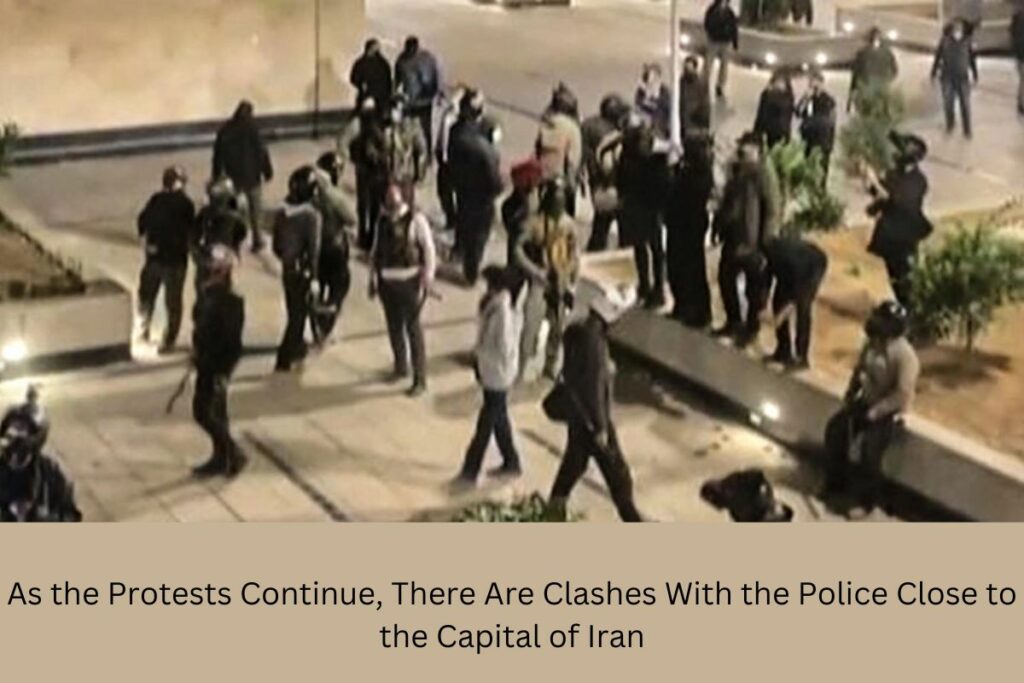According to this image screenshot from a UGC video published on November 1, 2022, Iranian security personnel is issuing warnings to the inhabitants of a complex in Tehran’s Chitgar neighborhood. According to this image screenshot from a UGC video published on November 1, 2022, Iranian security personnel is issuing warnings to inhabitants of a complex in Tehran’s Chitgar neighborhood.
On Thursday, protestors in Iran clashed with police in a hamlet close to the capital, reportedly killing or injuring a number of officers. At one point, the security forces fired stun grenades at the protesters from helicopters.
It was the most recent in a string of protests that have shaken Iran for more than six weeks and represent one of the most significant threats to the country’s clerical leaders since they took control during the 1979 Islamic Revolution.
The demonstrators gathered in Karaj, a small town outside of Tehran, to commemorate the 40th day since Hadis Najafi, 22, was shot and murdered during the demonstrations. She was one of the numerous young ladies who lost their lives. The death of a second lady detained by the nation’s morality police sparked the protests.
Will protests bring #Iran to revolution? Nonresident Senior Fellow @SaeidGolkar “doesn’t dismiss it entirely, because these security forces are also part of Iranian society, their families facing the same pressures as everyone else,” writes @sasapetricic. https://t.co/gwTcFYpQGe
— Chicago Council on Global Affairs (@ChicagoCouncil) November 3, 2022
In Shiite Islam, the 40th day following a person’s passing is significant and is observed by public mourning. The continuing protests have gained momentum as a result of memorializing protester deaths, just as they did during the 1979 uprising that toppled a monarchy with Western support.
Online videos that were shared showed thousands of protesters in Karaj and police skirmishes. In one of them, a helicopter hovers over the demonstrators, tries to scatter them by dropping flash grenades, and then lands in the middle of a roadway. Supporters of the government claimed on social media that the chopper was sent to help injured officers.
The state-run IRNA news agency aired a video of a police pickup truck colliding with a concrete barrier on a highway while tweeting that officers had been attacked nearby. Although the cause of the collision was not immediately known, videos showed demonstrators throwing rocks at the car and a man opening fire on it as at least three injured people were inside. Later, IRNA published images of what seemed to be two dead bodies.
Despite killing of hundreds of protesters and the arrest of more than 14,000 people, today there was a massive uprising in Karaj, and other cities in Iran, on the 40th day after the killing of protesters #HadisNajafi and other victims.#MahsaAmini pic.twitter.com/Y1FhOfYiFb
— Masih Alinejad 🏳️ (@AlinejadMasih) November 3, 2022
Three policemen were reported to have suffered significant injuries in fights with protesters, according to the semi-official Tasnim news agency. It wasn’t immediately obvious if it was discussing the same incident. Additionally, according to Tasnim, demonstrators set a police van and kiosk on fire.
According to the unofficial Fars news agency, a Basij militia member was fatally stabbed in Karaj. It is difficult to authenticate details of the unrest because Iranian authorities severely restrict media coverage of the protests and frequently shut off internet access nationwide.
Mahsa Amini, 22, was killed on September 16 after being arrested by the morality police for allegedly breaking Iran’s severe clothing code for women. Her killing was the catalyst for the protests. Authorities claim she passed away due to a medical ailment and were not negligent in her care, but her family has questioned this claim, and the demonstrators claim the police beat her to death.
At Amini’s funeral in her homeland in Iran’s Kurdish area, the first significant demonstrations broke out. The almost daily protests persisted and started up once more 40 days after she was buried. Initially, the focus of the demonstrations was Iran’s enforcement of the Islamic headscarf or hijab; amid loud public demonstrations, large numbers of young women removed their hijabs.
The cries for the overthrow of Iran’s theocracy, which has governed for more than 40 years, quickly spread from the demonstrations. At least 300 people have been killed and more than 14,000 others have been detained by security forces in an effort to suppress opposition, according to the Human Rights Activists in Iran organization, which has been monitoring the violence since the protests started. At least 36 members of the security forces have reportedly died.
More than a thousand protest participants, including those who attacked security personnel and set fire to public property, will stand trial in Tehran for their “subversive conduct,” according to Iran’s judiciary. In other Iranian regions, authorities have announced charges against hundreds of people, some of whom are accused of “corruption on earth” and “war against God,” crimes that are punishable by the death penalty.
The information provided here may help you, in which case you may like to visit our website. I recommend adding unitedfact.com to your bookmarks since its material is frequently refreshed with new and relevant data.

